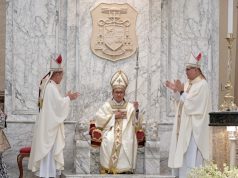
From R.I.P. to memories of their loved ones, a museum in Laguna listed common inscriptions written on the tombstones at a historical cemetery.
In a post on October 31, the Nagcarlan Underground Cemetery in Nagcarlan, Laguna offered this information to potential tourists amid Undas or commemoration of the dead in the Philippines.
“Whenever you visit a cemetery, do you take time reading epitaphs on tombstones? Is there any message that has made a mark on you?” the post reads.
It also accompanied some photos of tombstones with epitaphs.
The cemetery’s Facebook page first provided a definition of an epitaph, citing the Merriam-Webster Dictionary.
The online dictionary defined epitaph as “an inscription on or at a tomb or a grave in memory of the one buried there.”
It is also “a brief statement commemorating or epitomizing a deceased person or something past.”
The Nagcarlan Underground Cemetery page also described this written text as a form of “memorial” for the departed person.
“A memorial, this inscription is often a short and a sweet phrase of honor, love and respect from the living to their departed loved one, and commonly includes a brief record of the deceased,” it said.
The page listed common epitaphs written on tombstones that visitors can see at the Nagcarlan Underground Cemetery, also known in Filipino as “Museo sa Ilalim ng Lupa ng Nagcarlan.”
These include the following:
- R.I.P (English, “Rest in Peace”, Latin, “Requiescat In Pace”)
- S.L.N (Filipino, “Sumalangit Nawa”)
- E.P.D (Spanish, “En Paz Descanse”, translated as “rest in peace”)
- Alaala ng Nagmamahal na Asawa, Mga Anak at Kapatid
- Family Remembrance
As the name states, the Nagcarlan Underground Cemetery is an old underground crypt that was built in Laguna in 1845 under the auspices of Franciscan Fr. Vicente Velloc.
In 1981, it was declared a National Historical Landmark that is under the National Historical Commission of the Philippines.
According to NHCP’s website, the site was used to bury the town’s elite during the Spanish occupation.
“During the revolution against Spain and the war against the United States, the Underground Cemetery was used as a rendezvous of Filipino revolutionaries. Similarly, the cemetery served as a hideout for guerrillas resisting the Japanese occupation in World War II,” the webpage reads.
The museum was, therefore, established to highlight its heritage.









